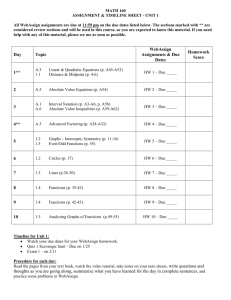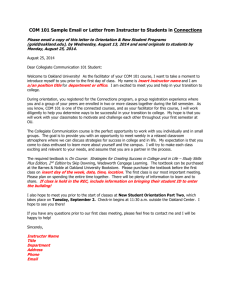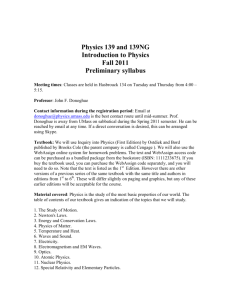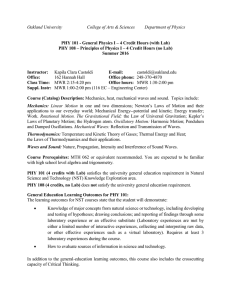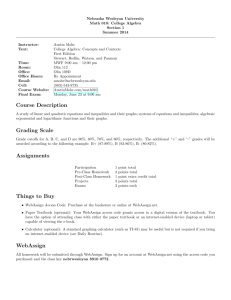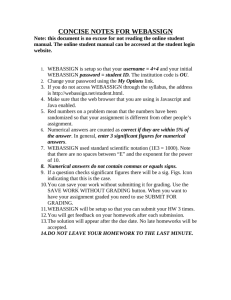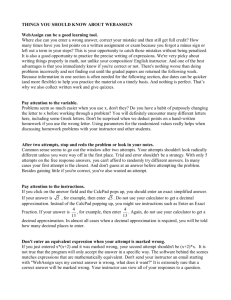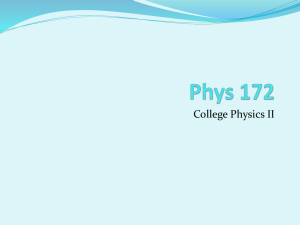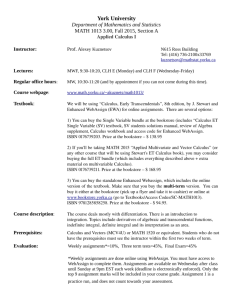Phy 101 Syllabus
advertisement
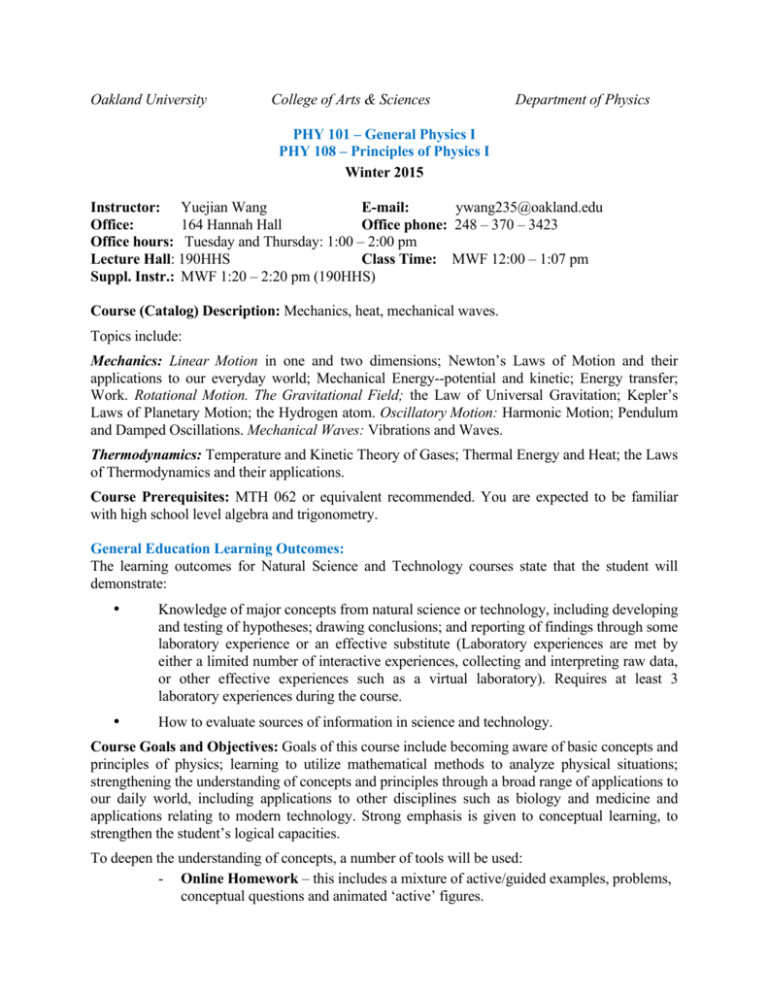
Oakland University College of Arts & Sciences Department of Physics PHY 101 – General Physics I PHY 108 – Principles of Physics I Winter 2015 Instructor: Yuejian Wang E-mail: ywang235@oakland.edu Office: 164 Hannah Hall Office phone: 248 – 370 – 3423 Office hours: Tuesday and Thursday: 1:00 – 2:00 pm Lecture Hall: 190HHS Class Time: MWF 12:00 – 1:07 pm Suppl. Instr.: MWF 1:20 – 2:20 pm (190HHS) Course (Catalog) Description: Mechanics, heat, mechanical waves. Topics include: Mechanics: Linear Motion in one and two dimensions; Newton’s Laws of Motion and their applications to our everyday world; Mechanical Energy--potential and kinetic; Energy transfer; Work. Rotational Motion. The Gravitational Field; the Law of Universal Gravitation; Kepler’s Laws of Planetary Motion; the Hydrogen atom. Oscillatory Motion: Harmonic Motion; Pendulum and Damped Oscillations. Mechanical Waves: Vibrations and Waves. Thermodynamics: Temperature and Kinetic Theory of Gases; Thermal Energy and Heat; the Laws of Thermodynamics and their applications. Course Prerequisites: MTH 062 or equivalent recommended. You are expected to be familiar with high school level algebra and trigonometry. General Education Learning Outcomes: The learning outcomes for Natural Science and Technology courses state that the student will demonstrate: • Knowledge of major concepts from natural science or technology, including developing and testing of hypotheses; drawing conclusions; and reporting of findings through some laboratory experience or an effective substitute (Laboratory experiences are met by either a limited number of interactive experiences, collecting and interpreting raw data, or other effective experiences such as a virtual laboratory). Requires at least 3 laboratory experiences during the course. • How to evaluate sources of information in science and technology. Course Goals and Objectives: Goals of this course include becoming aware of basic concepts and principles of physics; learning to utilize mathematical methods to analyze physical situations; strengthening the understanding of concepts and principles through a broad range of applications to our daily world, including applications to other disciplines such as biology and medicine and applications relating to modern technology. Strong emphasis is given to conceptual learning, to strengthen the student’s logical capacities. To deepen the understanding of concepts, a number of tools will be used: - Online Homework – this includes a mixture of active/guided examples, problems, conceptual questions and animated ‘active’ figures. Upon completion of this course, the student will be able to: - Utilize general methods of problem solving to sharpen his/her critical thinking capacity. Convert between systems of units and use these as an aid in problem solving. Add and subtract vectors graphically and be able to resolve them into components. Describe the motion of an object moving in one dimension. Describe the motion of an object moving along a curved path; apply kinematic equations Construct free-body diagrams and use these to analyze mechanical systems using Newton’s Laws of Motion. Analyze the motion of a satellite in a circular orbit, as well as other objects moving in circular paths. Utilize the principle of Conservation of Energy to solve problems, such as the motion of a roller coaster. Utilize the principle of Conservation of Linear Momentum to solve problems, such as a collision between two cars. Describe the motion of an object moving in a circular path using angular quantities. Apply Newton’s Laws to circular motion and understand the concepts of torque, moment of inertia, and angular momentum. Understand the dynamics of a mass-spring system and an oscillating pendulum. Compare concepts of pressure and density in solids, liquids, and gases and apply to medical phenomena. Convert temperature readings in one scale to any other and apply concepts of specific heat and latent heat to thermal transfer situations, such as cooking. Analyze the behavior of gases utilizing the Ideal Gas Law. Apply the Laws of Thermodynamics to systems and relate them to the increasing entropy of the universe. Calculate the efficiency of any engine that utilizes heat transfer. Textbook: Serway/Vuille: College Physics – 10th Edition, Hybrid version packaged with: - Enhanced Web Assign (EWA) Access Card - EWA Start Smart Guide - Access to the interactive e-book Cengage Publishing – ISBN: 9781285761954 Serway/Vuille: Student Solutions Manual with Study Guide Vol. 1 – 10th Edition Cengage Publishing – ISBN: 9781285866253 [Required] [Suggested] Castoldi: General Physics Laboratory I Manual for Phy 101 and Phy 151 Courses– 2nd Edition Cengage Custom – ISBN: 9781305017313 [Required for Phy 101] Available options for purchasing the textbook: • You may purchase the entire ‘bundle’ at o Campus bookstore – Barnes & Noble – at the Oakland Center o Textbook Outlet – 2592 N. Squirrel Rd. @Walton • You may purchase the materials online, directly from the publisher. The direct link to the Hybrid version with Enhanced Web Assign is: http://www.cengagebrain.com/shop/isbn/9781285761954 Several other options are listed on the webpage for the Hardcover book: http://www.cengagebrain.com/shop/isbn/9781285737027 o E-book o E-chapters o Rental textbook program with option to buy afterwards It is up to you to compare costs and decide which way to go. Please notice: • The Hybrid format of the textbook is cheaper than the hardcover one. It does not include end-of-chapter problems, but these can be found on the e-book. • The Access to Web Assign is valid for multiple terms (Phy 101 & Phy 102) • If you wish to purchase just the access to WebAssign, you may do so: o Online as you login to WebAssign.net. (Please see the page of the syllabus dedicated to WebAssign: How to get started) o At the bookstore or online at Cengagebrain.com. The ISBN of the printed EWA Multi Term Access Card with e-book is: 9781285858401 Equipment: Protractor, metric ruler, fine point retractable pencil, basic scientific calculator with trigonometric functions, pack of white index cards. Pre-class Preparation: Prior to the class, the lecture notes (power Points) will be posted on Moodle. You are required to have read the lecture notes as well as the corresponding contents in the textbook. It is suggested that you print a copy of the notes and bring those to class, so that you can focus more on the conceptual understanding of the topics discussed in class and maybe add just a few notes on the side of the sheets. Study Tips: In order to develop Critical Thinking (one of the main goals of this course) much emphasis in this class will be on the understanding and assimilation of ‘concepts’. You are strongly encouraged to review the chapter’s Active Examples on the textbook and the animated Active Figure tutorials on the e-book. Also, in order to test your understanding of concepts, you should test yourself by trying all the Quick Quizzes interspersed in each chapter (answers to be found at the end of the textbook) and the end-of-chapter Conceptual Questions. Ideally, you should find one or two partners in the class and work with them at least once a week for a few hours outside class time. Supplemental Instruction: Supplemental Instruction is provided by the Tutoring Center. SI will meet for an hour after each lecture as a support for the students. The SI leader will lead you through extra problem solving, review difficult concepts, and answer any questions you may have. SI will also allow you to work in a much smaller environment than our large class. Participation to the SI is not mandatory, but strongly encouraged. Other Help: Several other forms of help are available on campus. The Tutoring Center offers free individual and group peer tutoring and also space to gather and study with peers. Available on the Tutoring Center’s website are a series of short videos on Math 061 & 062 topics. Go to www.oakland.edu/tutoring and click on Study Area on the left of the screen; then on the MTH 061 &062 tab. Last but not least, you may meet me during office hours (or request a special appointment) to get help with course material, discuss ways of improving your performance, and to ‘stick out of the crowd’ get known personally by the instructor. Math Review: Good Math skills are an essential pre-requisite for a Physics course. During the first week of classes you are requested to login to: https://espace.oakland.edu/course/view.php?id=560 Here you will find five short math review tutorial videos on Unit Conversion, Exponents, Scientific Notation and Significant Figures, Formula Manipulation, and Trigonometry and the Pythagorean Theorem. You must take short quizzes at the end of each video and a final Quiz for Certification. Follow the instructions on eSpace on ‘How to save your score’ to print the result of this final quiz and bring it promptly to class. Based on the score of this quiz, the instructor will direct you to the proper course of action. This may include mandatory attendance to Supplemental Instruction, seeking help at the Tutoring Center, etc. Homework: The online program WebAssign will be utilized for entering and automatic grading of the homework. This requires the Access Card to be found inside the textbook. The homework for each chapter can be submitted a maximum of 5 times. Accessing WebAssign: see attached sheet. Due time: The assignments are due on the date specified on WebAssign. Only in case of serious circumstances an extension may be granted. Please send me an e-mail about this. No e-mailed homework is accepted. Grace period: there is a 14 day grace period in Web Assign during which you may do the homework even if you do not have an Access Code. An Algebra Review tool is also available on WebAssign. It provides students with a self-paced environment for extra practice with the mathematical skills required for success in the physics course. The homework is worth 20% of the final grade. Exams: There will be a total of three exams, consisting of multiple choice problems. All exams are closed-book. You may bring a 4.25” x 5.5” sheet with formulae; You can write on both sides of the sheet with hand written formulae, relevant constant, and personal notes, but no examples of solved problems. Notice: The index card may not be photocopied, reduced or computer generated. Violation of this rule will result in failure of the examination. Please notice that clear writing and clarity of expression is a very important component of the exam. A calculator is required, plus a fine point pencil, and an eraser. Exam # 1: Friday, Feb. 6 Exam # 2: Monday, Mar. 16 Exam # 3: Monday, Apr. 27 at 12:00 PM! (Chapters 1, 2, 3, 4) (Chapters 5, 6, 7, 8) (Chapters 9, 10, 11, 12, 13) Make-up Policy: In order to be fair to the majority of students who take the exams on time, the general policy is: No make-up exams will be given. A score of zero will be entered for missed a test. If you cannot be present for an exam due to a documentable serious and unavoidable emergency, contact me before the exam, if possible, or as quickly as possible after the exam to see if an exception can be made. Grading: Course grades will be posted on Moodle. Homework + Extra credits 20% Exam 1 25% Exam 2 25% Exam 3 30% The full point of homework is 1300. During class, you may get chance to receive extra credit by answering questions raised by instructor or participating in other forms of interactions and activities requested by instructor. The maximum extra credit that can be received by an individual student per lecture is 3 points. Grading scale: Grade 4.0 3.9 3.8 3.7 3.6 3.5 Total score 96-100 or above 93-95 90-92 87-89 85-86 83-84 3.4 3.3 3.2 3.1 3.0 2.9 2.8 2.7 2.6 2.5 2.4 2.3 2.2 2.1 2.0 1.9 1.8 1.7 1.6 1.5 1.4 1.3 1.2 1.1 1.0 81-82 79-80 77-78 75-76 74 73 72 71 70 79 68 67 66 65 64 63 62 61 60 59 58 57 54-56 51-53 50 Common Courtesy Guidelines: For the benefit of your fellow students and your instructor, you are expected to practice common courtesy with regard to all course interactions. Take responsibility for your education Instructors are here to create a learning environment – whether or not you learn depends on your willingness to listen, ask appropriate questions, and do the work necessary to pass the course. Attend class Students who attend class, listen to the instructor, ask questions, and take good notes are more likely to pass with a higher grade. If you must miss a class, contact your instructor ahead of time to let him or her know that you will not be in class. DO NOT ask the instructor to repeat material you missed because you skipped a class. Do not leave class early, and do not rustle papers in preparation to leave before class is dismissed. Be on time Walking in late disturbs everyone. At this college and many places of employment, tardiness communicates lack of interest and lack of dependability. If you cannot avoid being late, make sure to be unobtrusive about your entry. Be attentive in class and participate Turn off your cell phones and put away iPods and other devices before class begins. Do not chat with your neighbor during class. Stay awake; no text messaging, listening to iPods, or surfing the Internet... Don’t ask these questions which are classic sources of annoyance for professors: • “I missed class – did you do anything important.” • After chatting with your friend for five minutes, “Could you repeat that?” • In the middle of a fascinating discussion on a new concept: “Will this be on the test?” • At the end of the semester after missing numerous assignments: “Is there extra-credit in this class?” Add/Drops: The University’s add/drop policy will be explicitly followed. It is the student’s responsibility to be aware of the university deadline dates for dropping courses. Special Considerations Students with a documented learning or physical disability must contact the Office of Disability and Support Services, 121 North Foundation Hall, (248) 370-3266, and inform the instructor of special needs during the first week of classes. For more information, visit http://www.oakland.edu/dss. Policy on Academic Misconduct The University’s regulations that relate to academic misconduct will be fully enforced. Any student suspected of cheating and/or plagiarism will be reported to the Dean of Students and, thereafter, to the Academic Conduct Committee for adjudication. Anyone found guilty of academic misconduct in this course may receive a course grade of 0.0, in addition to any penalty assigned by the Academic Conduct Committee. Students found guilty of academic misconduct by the Academic Conduct Committee may face suspension or permanent dismissal. The full policy on academic misconduct can be found in the General Information section of the Undergraduate Catalog. Excused Absence Policy University excused absences applies to participation as an athlete, manager or student trainer in NCAA intercollegiate competitions, or participation as a representative of Oakland University at academic events and artistic performances approved by the Provost or designee. For the excused absence policy, see http://www.oakland.edu/?id=6850&sid=175. WebAssign: How to Get Started Day One: Register 1. Go to https://webassign.net and click on LOG-IN. 2. Click on ‘I have a Class Key’ 3. Enter the Class Key: oakland 2875 9773 (this allows me to see your homework grades) 4. Enter your chosen Login name and the required information 5. Click on ‘Create my Account’ A review screen will appear with your Username, Institution code & Password. Print and retain a copy of this information. 6. Once you Login, you need to enter the WebAssign Access Code. - If you purchased a new textbook, the Access Code card is inside the book. - If you purchased a used book, you may choose to purchase the Access Code online. 7. Once you have logged in, you will see the Homepage. - I suggest you click on Guide (upper right corner) and read the Student Guide. - For Technical Support click on Help or go to http://www.webassign.net/info/support/report.html Notice: there is a 14 day grace period in Web Assign during which you may do the homework even if you do not have an Access Code. You may want to watch the short Student Self-Enrollment video: http://www.wadsworthmedia.com/tlc/EWA_StudentVideos/Self_Enrollment/EWA_Student_Self Enrollment.html ~~~ To access the Homework: 1. Go to http://www.webassign.net/login.html (I suggest you Bookmark this page) 2. After you Login, click on ‘My Assignments’. Please notice: - You may save your work without grading by clicking on ‘Save Work’ at the end of the question. When next time you access the assignment, your work will still be available. WebAssign will not automatically submit your answer if you only ‘Save’ your work. Make sure you ‘Submit’ it before the due date and time. You may also choose to ‘Submit New Answers to Question xx’ or ‘Submit All New Answers’. Remember that there is a maximum of 5 submissions for each problem. PHY 101 TENTATIVE SCHEDULE – WINTER 2015 Week 1 2 3 4 5 6 7 8 9 10 11 12 13 Day Date W 1/7 F 1/9 M W F M 1/12 1/14 1/16 1/19 W 1/21 F 1/23 M 1/26 W F M W F M W 1/28 1/30 2/2 2/4 2/6 2/9 2/11 F 2/13 M 2/16 W 2/18 F 2/20 2/23-2/27 M 3/2 W ¾ F M W 3/6 3/9 3/11 F 3/13 M 3/16 W 3/18 F 3/20 M 3/23 W F M W 3/25 3/27 3/30 4/1 Chapter 1 2 Lecture contents Syllabus; Standards of Length; Mass; and Time Structure of Matter; Dimensional Analysis; Uncertainty and Significant Numbers; Conversion of Units; Order of Magnitude Coordinates Systems; Trigonometry; Problem-Solving Strategy Displacement; Velocity Acceleration; Motion Diagram Martin Luther King Jr. Day, classes suspended 2 3 4 One-dimensional motion with constant acceleration; Freely Falling Objects Vector; Components of a Vector Displacement, velocity, and Acceleration, and Motion in Two Dimensions Motion in Two Dimensions, Relative Velocity Newton’s Laws Applications of Newton’s Law Friction Force Due date of home work 1/14 1/23 1/30 2/5 EXAM 1 (Chapters 1-4) 5 6 Work; Kinetic Energy and the Work-Energy Theorem Gravitational Potential Energy Spring Potential Energy; Energy Conservation; Power; Work Done by a Varying Force Momentum and Impulse; Conservation of Momentum Collisions Glancing Collisions; Rocket Propulsion 2/15 2/21 Winter recess, classes suspended 7 8 Angular Speed and Angular Acceleration; Rotational motion Relations Between angular and Linear Quantities; Centripetal Acceleration Newtonian Gravitation; Kepler’s Laws Torque; Mechanical Equilibrium The Center of Gravity; Example Torque and Angular Acceleration; Rotational Kinetic Energy; Angular Momentum 3/7 3/15 EXAM 2 (Chapters 5-8) 9 10 11 States of Matter; Density and Pressure; The Deformation of Solids Variation of Pressure with Depth; Pressure Measurements; Buoyant Forces and Archimedes’ Principles Fluids in the motion; Applications of Fluid Dynamics; Surface Tension, Capillary Action, and Viscous Fluid Flow; Transport Phenomena Temperature; Thermometers and Temperature scales; Thermal Expansion Ideal Gas; Kinetic Theory of Gases Heat and Internal Energy; Specific heat; Calorimetry; Latent Heat and Phase Change 3/24 3/29 4/5 14 15 16 16 F 4/3 M 4/6 W F M 4/8 4/10 4/13 W 4/15 F 4/17 W W 4/20 4/27 12 13 Energy Transfer Work in Thermodynamic Process; The First Law of Thermodynamics; Thermal Processes; Heat Engines; The Second law of Thermodynamics Hooke’s Law; Elastic Potential Energy Simple Harmonic Motion; Position, Velocity, and Acceleration as a Function of Time; Motion of a Pendulum; Damped Oscillations Waves; Frequency, Amplitude, and Wavelength; The Speed of Waves on Strings; Interference of Waves; Reflection of Waves REVIEW Final exam (Chapters 9-13), 12:00-3:00 PM 4/11 4/19
